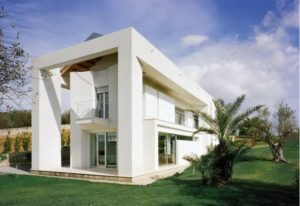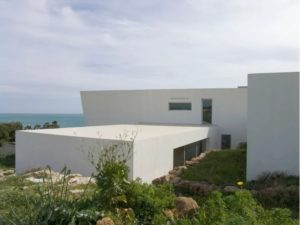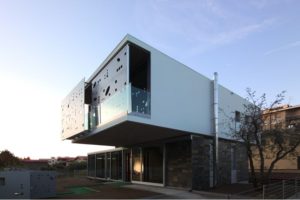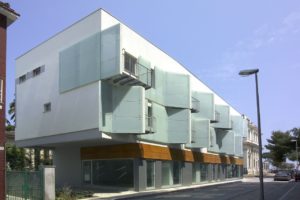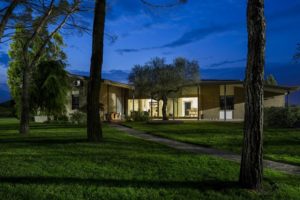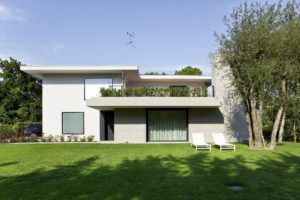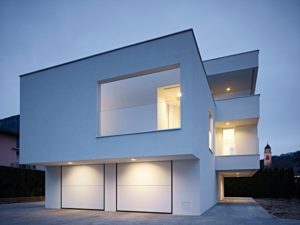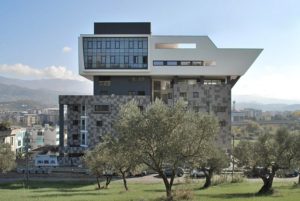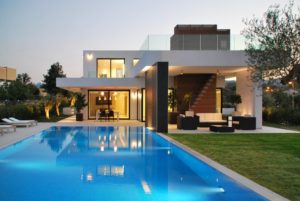Il sito inteso come luogo edificatorio ha svolto nei confronti dell’impianto di casa Granata un ruolo fondamentale.
Una “sottile” striscia di territorio che si svolge dolcemente lungo il pendio, osserva discretamente la splendida vallata del versante calatino di Grammichele.l’edificio, progettato nel 1998, ultimato nel 2006, è frutto della collaborazione fra Giuseppe Merendino (Pekstudio) e Rosario Sgroi (Studio Archè). Gli architetti hanno ideato un impianto longitudinale che di fatto, sembra incastrare la casa nel terreno privilegiando gli affacci sulla valle. In un curioso gioco distributivo le funzioni di zona giorno e zona notte si incastrano ad x svolgendosi entranbe sui due livelli di vita dell’edificio. La scelta di rapportare l’ architettura al paesaggio e far appartenere il paesaggio all’architettura è stata alla base della volontà di selezionare opportune bucature nel volume dell’edificio, tali da introiettare la natura circostante.
Casa Spinale, ad Augusta, è fortemente caratterizzata dalla configurazione del lotto in cui sorge. Una stretta lingua di territorio larga 50 mt e lunga un chilometro, scende lungo un pendio affiancato dal letto di un torrente fino al mare. Le direttrici fondamentali del progetto inquadrano longitudinalmente il mare e trasversalmente il vulcano Etna e diventano l’occasione irrinunciabile di orientamento del cannocchiale del livello superiore che ospita le attività della zona a giorno, e dello svuotamento del fronte mare del piano interrato che ospita le funzioni della zona notte.
Casa C+V
Casa Capece_Venanzi è una casa suburbana; una casa nata nella conurbazione diffusa della costa
adriatica in una delle possibili aree di una città qualsiasi nel segmento tra Ascoli e Pescara. Un’area “intermedia”, (apparentemente) “senza qualità”, un lacerto di terra rimasto senza costruzioni, all’ attacco tra la pianura e la collina, in un brano di città in cui il tessuto urbano presenta le prime “smagliature”. L’idea progettuale è quella di costruire un edificio con un orientamento completamente rivolto verso la collina, collina che viene vista come una sorta di “mare” verde su cui affacciarsi. L’impianto è definito da uno sviluppo in sezione su tre livelli:
– Livello interrato completamente scavato nel terreno:
Un patio interno è l’elemento intorno al quale si organizzano gli spazi, costruendo un gioco di
traguardi tra gli spazi interrati/il tetto giardino/l’area giorno(pt), il volume sospeso del piano secondo.
– Primo livello/piano terra: è la parte collettiva dell’edificio, dove una grossa vetrata scorrevole segna il
confine tra il tetto giardino scoperto e l’area giorno coperta. Lo spazio ruota intorno ad una scala metallica lamellare che si connette con il piano primo.
– Il piano primo: accoglie le camere e gli spazi privati dell’edificio (bagno/sauna, palestra, studio). L’argomento compositivo principale è giocato sulla metafora della trasposizione macroscalare di un
pezzo del gioco del tetris. I due volumi contrapposti mettono in scena le due parti dell’edificio e ne denunciano la diversità di uso, con un duplice trattamento materico: un basamento rivestito in pietra con un volume di intonaco bianco. Il basamento in pietra è “tagliato” sul fronte ovest da una vetrata a tutta altezza, mentre il volume stereometrico sovrapposto al piano terra presenta una trama di bucature di forma libera e circolare. La serie di bucature libere sono, inoltre, la trama del disegno dei pannelli in alluminio che schermano le grosse bucature sud-ovest e che “slittano”al piano terra disegnando recinzione, cancello e sistemi di chiusura. La luce è uno dei materiali del progetto. Il sistema
di bucature ritagliate nella muratura e nel solaio di copertura disegna, durante il giorno, le ombre e le luci portate all’interno del volume del secondo piano; al piano terra la luce inonda tutti gli spazi. Di notte un sistema di illuminazione a led (gestito da un controller) definisce una serie di “sfondi”
che trasformano il fronte vetrato del piano primo in una parete luminosa. Nel gioco dei contrari, sulla parete vetrata (luminosa) si appoggia a sbalzo il volume del piano primo.
Ex arena braga
Il sito è parte del tessuto urbano d’espansione di una città della lunga conurbazione diffusa della costa adriatica; esso è posto alle spalle di uno dei più vecchi e gloriosi edifici ludici: il Kursaal. L’edificio è disposto su un lotto rettangolare allungato con orientamento est-ovest, a ridosso del lungomare; i temi del progetto si misurano con la risoluzione tipologica e morfologica di una serie di istanze che ad una prima lettura sono fortemente penalizzanti:
– la geometria notevolmente allungata;
– la destinazione d’uso del piano terra (attrezzature e servizi_cinema) che richiede un attacco a terra completamente libero;
– la presenza, sul lato sud, di un edificio molto alto e ravvicinato.
Il progetto reinterpreta tutto ciò tentando di renderli elementi di connotazione architettonica:
– la distribuzione verticale, al fine di rendere fruibile il piano terra senza soluzione di continuità, è stata posta in testata diventando essa stessa prospetto (principale) emettendo in scena il sistema dei flussi dell’edificio;
– il tema dell’introspezione e della regolazione/captazione della luce, indotto dalle forti presenze di confine, è diventato l’argomento generatore di una pelle in vetro che avvolge l’edificio, diventa l’interfaccia tra interno esterno, regolatore della luce ed elemento unificante che camaleonticamente muta geometria e forma “registrando” gli usi molteplici che avvolge. Una pelle che si sfoglia e piega costituendo uno schermo di protezione visiva ed allo stesso tempo una macchina per la captazione della luce. La pelle è si luogo dei riflessi, dei riverberi visivi; le finestre scompaiono, le “squame” disegnano tagli e sporti, una sorta di superficie “a spessore”. Nello spessore sono raccolti degli affacci a sbalzo in acciaio traforato che traguardano, come dei punti di avvistamento, il mare.L’edificio accoglie delle residenze temporanee per vacanze. L’idea, anche in ragione della morfologia fortemente allungata
dell’edificio, è quella di pensare questi spazi quasi come spazi nautici più che come residenze piantate sulla terraferma; l’accesso a tutti gli alloggi avviene da un lungo “ponte” posto all’ ultimo piano, da cui si distribuiscono gli ambienti giorno degli alloggi. Dall’open space soggiorno/cucina con delle scale (in ferro e legno) interne si possono raggiungere le cuccette/camere al piano inferiore (in coperta) o risalire sul ponte/terrazzo posto al piano superiore. Il sistema degli alloggi “galleggia”su di un piano terra completamente svuotato e smaterializzato nel suo attacco a terra da una lunga vetrata. Il confronto,all’interno di un tessuto edilizio amorfo, con l’unica emergenza rappresentata dall’edificio novecentesco del Kursaal è cercato nel continuo contrapporre forme e materiali che tentano di interpretare la leggerezza (vetro, metallo, laminato) alla matericità delle masse murarie intonacate del kursaal. Negli occhi di chi scrive si riflettono le immagini della lama di mosaico bianco che si affaccia tra gli edifici neoclassici di corso Italia a Milano o la casa della cooperativa Astrea e “il girasole” di viale Buozzi a Roma. Le istanze funzionali sono il pretesto per misurarsi con il patrimonio di progetti e realizzazioni consegnatoci dagli architetti italiani degli anni 50/60. Un brano di storia di estremo interesse, poiché ci si è misurati con l’ibrido, il molteplice, l’incerto. Una condizione spuria che, credo, appartenga al nostro lavoro.
Un omaggio a Luigi Moretti.
Il progetto prevede la ristrutturazione di una villa degli anni ’60.
Attraverso la demolizione dei precedenti divisori interni e il mantenimento dei soli pilastri e porzioni di pareti strutturali è stato realizzato un unico ambiente per la zona giorno.
Il ridisegno delle forometrie in seguito ai cambiamenti dell’interno, ha modificato parzialmente le facciate esistenti introducendo nuovi elementi che dialogano con l’architettura originale della casa.
Una grande finestra a sud, come oggetto “aggiunto” sottolinea il nuovo intervento nella zona giorno e migliora il rapporto con il grande giardino esterno.
All’interno sono stati impiegati per i rivestimenti e per l’arredo, due soli materiali: il rovere naturale e il basalto.
La nuova organizzazione dello spazio interno prevede un grande camino centrale rivestito di pietra, posto tra cucina e salotto e il ridisegno dei mobili della cucina in legno di rovere naturale e acciao
Il progetto prevede l’ampliamento e la ristrutturazione di una casa degli anni ‘70 in una lottizzazione residenziale dello stesso periodo.
L’edificio esistente, di due piani con tetto a padiglione e profonde cornici di gronda, ospitava al piano terra i depositi e il garage, mentre al primo livello si distribuivano gli ambienti abitabili.
Il progetto non nega la volumetria originaria, ma attraverso il nuovo ampliamento e il ridisegno delle facciate esistenti, ne modifica radicalmente funzionamento interno, estetica e rapporto con il giardino.
Al piano terra viene collocata tutta la zona giorno attraverso la demolizione di parte dei muri divisori esistenti e la realizzazione del nuovo ampliamento in cemento armato a vista, come prolungamento del soggiorno verso il giardino, in forma di divano-finestra e zona camino.
Il piano primo viene destinato alla zona notte e all’area gioco per i bambini: da qui e dalla camera padronale si può accedere al piccolo terrazzo-giardino posto in copertura del nuovo ampliamento.
Particolare attenzione è stata posta al ridisegno delle facciate per migliorare gli affacci verso il giardino e per favorire l’utilizzo della luce naturale.
L’edificio unifamiliare BL si trova nella zona nord del Comune di Pergine, su di un terreno mediamente piano. Dall’area si gode una bellissima vista sul castello e sulla chiesa arcipretale di Pergine, sul gruppo del Brenta e altri rilievi minori; il soleggiamento è ottimale per tutto l’anno, permesso sia dai profili montani che dagli edifici circostanti. Il progetto prevede la ristrutturazione edilizia e ampliamento di un edificio degli anni ’60, su due piani più soffitta, per adattarlo alle esigenze dei nuovi proprietari. Il volume è costituito da un corpo di fabbrica di tre piani fuori terra. La particolarità del luogo e dell’edificato esistente, hanno suggerito di rendere molto compatto, basso e articolato il volume costruibile. Si sono volute ridurre visivamente le dimensioni e l’impatto del fronte principale, usando le logge invece dei balconi e trattando parte del secondo piano, destinato a copertura con falde, come uno spazio aperto con veranda.
All’esterno l’intervento è caratterizzato da grandi aperture vetrate protette; esse permetteranno sia di beneficiare del contributo solare in inverno e di proteggersi dal surriscaldamento estivo, sia di godere a pieno del bellissimo panorama. Sulla copertura a falda della veranda, troveranno posto i pannelli solari, posizionati secondo la pendenza della copertura, per garantire un impatto visivo praticamente nullo.
I prospetti, le tende esterne, gli infissi basso emissivi in legno e alluminio, presentano un’unica cromia, il bianco, non presente in nessuna delle singole tinte presenti sugli edifici vicini. La loro sommatoria è rappresentata proprio dal colore bianco la cui caratteristica è di contenere tutti i colori dello spettro elettromagnetico e quindi del contesto. L’alloggio ha il piano interrato destinato a cantine e locale tecnico, il piano terra dotato di garage, ingresso con zona armadi, deposito ed il piano primo caratterizzato dall’alloggio della famiglia. L’elemento di collegamento verticale, la scala, nella posizione baricentrica in cui si trova permette di valorizzare appieno la superficie destinata all’alloggio.
L’obiettivo di un edificio a risparmio energetico viene raggiunto anche attraverso la razionalizzazione della distribuzione interna, dotando il volume di grandi aperture a sud-est per sfruttare il più possibile i vantaggi del soleggiamento in periodo invernale, proteggendosi nel contempo dal surriscaldamento estivo mediante l’uso delle logge.
Polignano a Mare è una suggestiva località in provincia di Bari, affacciata sul Mare Adriatico con una costa alta e frastagliata, intervallata da affascinanti insenature e grotte marine. A poca distanza dalla costa, un’abitazione privata su quattro livelli ha sostituito un locale a pianoterra, parte di un complesso di più edifici attigui. La particolarità dell’intervento è data dalle numerose aperture di diverse dimensioni che caratterizzano i vari livelli su doppio affaccio, assieme al grande lucernario centrale. Tutte le aperture sono infatti inclinate rispetto all’asse, in modo tale da evitare l’ingresso diretto dei raggi solari, pur garantendo agli interni un’invidiabile illuminazione naturale.
